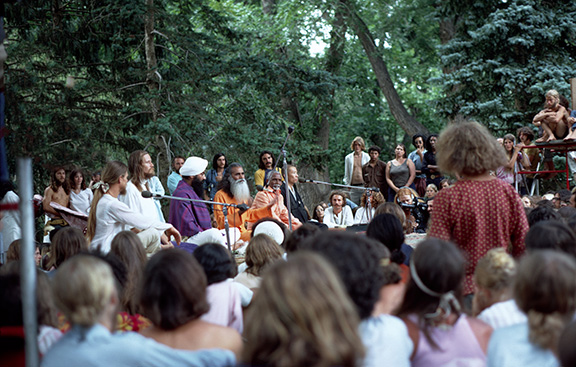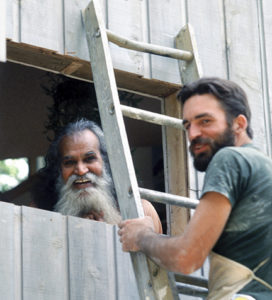
Holy Man Jam with Stephen Gaskin, Yogi Bhajan, Swami Satchidananda, Zen roshi.
In youth, my earliest spiritual urges came in the form of Roman Catholic community. I was in awe of the church structures, the architecture, the liturgy, the mystery. I served as an altar boy and had imaginings of becoming a priest. I was pious and sincere. Yet, something was off for me. I was aware that as a Catholic, I was somehow different from others, and felt reviled or not trusted in Protestant, Mormon, secular Idaho. I became shy about expressing myself as being a Catholic, though with the understanding that the word “catholic” meant “universal” I was left with a gnawing question as to why this sense of being different could persist. Eventually I edged away from the Catholic Church. They could not answer my questions, the primary one being “If God is our Father, we are all his children and He loves us all equally…Why is one child born with no arms, and another one whole? Why is one born with every advantage in life, and another with no hope?”
In my teens, during the mid ‘60s, the era of free speech, civil rights, anti-war, hippies, drugs and Rock & Roll, I experimented along all of those lines but also delved into the mystical writings of various spiritual traditions, shunning the dogmatic for the transcendent, continuing to question, embracing the continuity of life, of karma, of reincarnation. I began to seek God everywhere, and to sense a truly universal presence expressing through and binding together all of life. I practiced Zen meditation with one friend, became “born again” with my “Jesus Freak” friend, and began to practice Yoga on my own from books that seemed to be sent my way. Yet my fundamental urge to experience both outward and inward unity was unsatisfied.
In 1968, I was given the book Autobiography of a Yogi by the Indian sage Paramahansa Yogananda and first learned about the concept and possibility of a Guru. My sincere seeking made a surge and in 1969 I began to take Yoga classes in earnest. I continued to join my friends in their pathways, but now everything was falling into place. The unity in diversity was emerging like a pattern or picture in a tapestry, which had not been visible with myopic assertion. Now I could see the big picture and I loved it. The only thing missing for me was a Guru, someone to really show me the way to live it.
I began to take Yoga classes with a teacher who had come to California from New York, with his wife, to establish the Integral Yoga Institute (IYI) in San Francisco. When I first walked into the small apartment on Balboa Street where they lived and taught, I knew that I was home. On the book shelf were books by Swami Sivananda talking about Hinduism, Christianity, Judaism, Buddhism, Zoroastrianism, Islam—any and all religions and “isms” I could imagine—in a universal way.
Within a few months, I joined the IYI as a founding resident at a new location in a large house. I was now practicing Yoga in the context of community and becoming a Yoga teacher myself. I soon met the founder of Integral Yoga, Sri Swami Satchidananda, and became deeply involved in the work of transformation which being in community inspires, transforming “me” to “we,” and sharing the message and inspiration of unity in diversity from which Yoga springs.
Gradually over years, the teachings of Swami Satchidananda began to take form within the context of our Integral Yoga teaching centers and country ashrams. Swamiji’s maxim, “Truth is one, paths are many,” was a guiding exhortation to explore the unity underlying all religious traditions. A movement known as “Meeting of the Ways” began in San Francisco and coalesced into an annual festival that celebrated the richness of human diversity and the hope of human divinity. There were informal “Holy Man Jams” and gatherings at favorite parks, beaches and natural wonders, all in a spirit of peace and harmony.
At the same time, Swami Satchidananda was laying the foundations of the interfaith collaborations that became a lifelong current of his work as a spiritual teacher and friend of all. He brought religious and spiritual leaders together from various cultures and traditions who shared his vision of unity across all apparent differences of belief. In the early 1970s, he established Y.E.S., the Yoga Ecumenical Seminary, and together with other spiritual teachers conducted retreats where seekers could immerse themselves in the understanding of, “Truth is one, paths are many.” Out of these retreats a ceremony known as the “Yoga Ecumenical Service” [now known as the Light Of Truth Universal Service] was developed, in which all religious and wisdom paths were celebrated as participants honored the universal spirit together.
Finally, with the construction and opening of the Light Of Truth Universal Shrine (LOTUS) in 1986, Swami Satchidananda gave a physical expression of unity in diversity to the world and a unifying platform for the cause of peace in the world.
 About the Author:
About the Author:
Ramakrishna Sackett is a senior student of Sri Swami Satchidananda and founding member of Integral Yoga and Yogaville Virginia (he and his family were Yogaville’s first residents!). A Yoga teacher and poet, Ramakrishna he also spent decades as a master builder and carpenter. His skills contributed to the building of many of the structures that comprise Yogaville today. (photo: Ramakrishna Sackett with Swami Satchidananda during a building project in Yogaville East, Connecticut, late 1970s).

